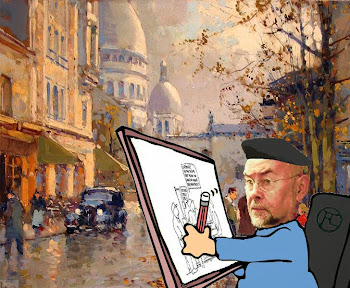I gave up history in school as soon as I could, which was after the Inter Cert. The history I was being taught was just a feat of memory work - kings, dates, battles, etc.. Boring oul shite. I can't have been alone, there must have been many other geniuses lost to history in those days.
But that was History, with a capital "H". Now, local history is something else entirely.
When people are trying to get your attention these days, they come up with natty little presentational techniques. So here goes: the three "P"s of local history - Passion, Persistence and Personality.
I'll get back to those, so keep them in mind.
The occasion which sparked this post was the launching of a local history book in Rathmines Library last evening. The book deals with the South Circular Road (SCR) at the start of the twentieth century, some hundred years ago. And it was being launched in Rathmines (Carnegie) Library, which this year is celebrating its own century. How more appropriate can it get.
The author is Cathy Scuffil, who lives in Dolphin's Barn, one of a number of Dublin villages joined up by the boulevard that is the SCR.
As Séamas Ó Maitiú remarked, as he launched the book, the SCR is not so much a road as an area of Dublin, and that is precisely what this book sets out to illustrate. It documents the road, or the area, or the succession of villages like jewels in a necklace. A fascinating, and thoroughly researched, commentary on the area's topographical features and physical development, its population and its religious, economic and social communities.
This is living history with a vengeance. You only have to look at how many of the footnotes cite the 1911 census and the newspapers of the day. And it is solid history, as is clear from the bibliography implied in those same footnotes. I won't spoil it for you, enough to say that the road was a microcosm of the middle-class Dublin of its day.
I'm not sure that Librarian, Helen O'Donnell, quite expected the large crowd that packed into the small room that once was the children's library. Friends, neighbours, work colleagues of Cathy's all turned up. Cathy is a people person, and who better to write up the history of her road.
Helen has her hands full, as this was only one of the many events celebrating the hundredth year of the Rathmines Library. Not only a significant building, as you can see from the illustration on the brochure below, but also, in common with all of Dublin's public libraries, both ancient and modern, a great community centre, reinforcing the sense of people and place.
In his launching speech, Séamas outlined his own connections not only with the SCR but also with Rathmines, where he lived and on whose history he is an authority. I have my own connections with Rathmines, having gone to school (briefly) in St. Louis, at the back of the library, having made my first Holy Communion in Rathmines church, and being related (by marriage) to the Fergusons, whose very posh cake shop, where I used to queue for the bus home, was just across the street from the library.
Séamas launched Cathy on her present academic path, and he was clearly proud of the achievements of his former pupil which culminated in this book, and which is part of the Maynooth Studies in Local History series. The book is a rewrite of Cathy's thesis for her Masters in Local History in Maynooth.
By the time Cathy took the floor, it was nearly time to go home. I think she may have intended to give us a flavour of the book, and put some flesh on the pictures of various aspects of the SCR which were rotating on the screen all during the launch. However, by the time she had thanked all those who had contributed to the birth of the book, and got over her shock of having more than sold out the box she had brought with her, it was time for the library to pack up for another day.
I first met Cathy through her PP, Fr. Gerry Fleming. She was going to visit the Somme to follow up some WWI family history leads and I had an uncle who was killed there and whose name is up on the Thiepval Memorial. Cathy took a photo of my uncle's name in stone and that was a very precious souvenir for me.
Gerry is also a native of the Dolphin's Barn area and, as well as being able to give Cathy access to parish records both there and in Rialto, I'm sure he had more to contribute from his own family background. He is also my cousin and has been feeding me a wealth of material on his branch of my family.
I said I'd come back to the three "P"s.
Passion: most people who are doing local history have got into it through some connection with place or family. So they are personally involved in their pursuit of the ultimately unattainable. They bring a passion to their quest, as you will quickly find out if you allow them to start talking about it.
Persistence: once they've got the bug, they just won't let go. And this type of research is like real life detective work. Ninety percent sweat and tears and ten per cent luck, when you hit the golden seam. I was advised to go into therapy before I started out on my own searches, and given some of what I found I can see why.
Personality: not necessarily of the researcher but of those they discover. I am constantly asked how far back I have got. Fortunately I can mention the period of the French Revolution in 1789, but that is not really the point. Most of the pleasure I have got from my searches has been in the personalities and stories of the characters I was chasing. I compare it to a tv soap, but this is your own soap.
Finally, I can claim my own family associations with the SCR.
The most direct is my rejection by Synge Street CBS, which I gather from last evening I share with Séamas.
My grandfather married out of Arnott Street, but his statistic is not included in Cathy's book as he is not recorded in the 1911 census. He was a commercial traveller and must have been away on the night of the census and not been recorded wherever he was staying the night. There might even be another story there if I had the patience to follow it up.
My great great-grandfather retired, with two of his daughters, to Bridge Stores, between the SCR and the canal, and these two maiden grand-aunts were on the receiving end of the German bombing of the SCR in May 1941.
My grand-uncle (by marriage), Paddy Medlar, lived for a while in Windsor House on the SCR in Dolphin's Barn/Rialto, but eventually ended up at Leonard's corner, where the family initially shared a house with two Jewish families and did the usual Sabbas Goyim needful for them at weekends.
Another maiden grand-aunt lived for a while in Curzon Street, as did my godmother.
So I'm not exactly detached in my reaction to the SCR.


















































































